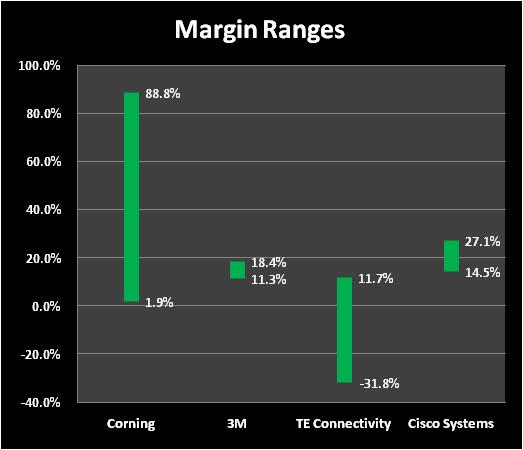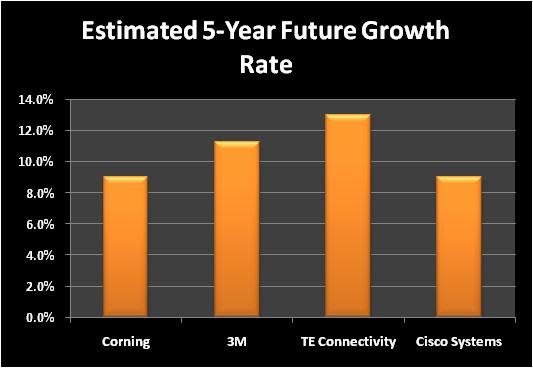Is Corning's Stock a Bargain by the Numbers?
Numbers can lie -- but they're the best first step in determining whether a stock is a buy. In this series, we use some carefully chosen metrics to size up a stock's true value based on the following clues:
The current price multiples.
The consistency of past earnings and cash flow.
How much growth we can expect.
Let's see what those numbers can tell us about how expensive or cheap Corning (NYS: GLW) might be.
The current price multiples
First, we'll look at most investors' favorite metric: the P/E ratio. It divides the company's share price by its earnings per share -- the lower, the better.
Then, we'll take things up a notch with a more advanced metric: enterprise value to unlevered free cash flow. This divides the company's enterprise value (basically, its market cap plus its debt, minus its cash) by its unlevered free cash flow (its free cash flow, adding back the interest payments on its debt). Like the P/E, the lower this number is, the better.
Analysts argue about which is more important -- earnings or cash flow. Who cares? A good buy ideally has low multiples on both.
Corning has a P/E ratio of 6.4 and an EV/FCF ratio of 8.5 over the trailing 12 months. If we stretch and compare current valuations to the five-year averages for earnings and free cash flow, Corning has a P/E ratio of 6.7 and a five-year EV/FCF ratio of 14.4.
A positive one-year ratio under 10 for both metrics is ideal (at least in my opinion). For a five-year metric, under 20 is ideal.
Corning is a mouthwatering four for four on hitting the ideal targets, but let's see how it compares against some competitors and industry mates (note that its closest competitors are Asian glassmakers that aren't traded on major U.S. exchanges, so these comps aren't ideal):
Corning | 6.4 | 8.5 | 6.7 | 14.4 |
3M (NYS: MMM) | 13.3 | 15.0 | 14.7 | 16.0 |
TE Connectivity (NYS: TEL) | 10.9 | 11.6 | 315.0 | 14.8 |
Cisco Systems (NAS: CSCO) | 15.9 | 7.3 | 14.1 | 7.6 |
Source: S&P Capital IQ.
Numerically, we've seen how Corning's valuation rates on both an absolute and relative basis. Next, let's examine...
The consistency of past earnings and cash flow
An ideal company will be consistently strong in its earnings and cash flow generation.
In the past five years, Corning's net income margin has ranged from 30.7% to 88.8%. In that same time frame, unlevered free cash flow margin has ranged from 1.9% to 31.6%.
How do those figures compare with those of the company's peers? See for yourself:

Source: S&P Capital IQ; margin ranges are combined.
Additionally, over the last five years, Corning has tallied up five years of positive earnings and five years of positive free cash flow.
Next, let's figure out...
How much growth we can expect
Analysts tend to comically overstate their five-year growth estimates. If you accept them at face value, you willoverpay for stocks. But while you should definitely take the analysts' prognostications with a grain of salt, they can still provide a useful starting point when compared to similar numbers from a company's closest rivals.
Let's start by seeing what this company's done over the past five years. In that time period, Corning has put up past EPS growth rates of 23.4%. Meanwhile, Wall Street's analysts expect future growth rates of 9%.
Here's how Corning compares to its peers for trailing five-year growth:

Source: S&P Capital IQ; EPS growth shown.
And here's how it measures up with regard to the growth analysts expect over the next five years:

Source: S&P Capital IQ; estimates for EPS growth.
The bottom line
The pile of numbers we've plowed through has shown us the price multiples shares of Corning are trading at, the volatility of its operational performance, and what kind of growth profile it has -- both on an absolute and a relative basis.
The more consistent a company's performance has been and the more growth we can expect, the more we should be willing to pay. We've gone well beyond looking at a 6.4 P/E ratio, and we see low price multiples all around. We also see consistent profitability and solid growth.
I really like the story of this premium glass producer. I laid out the "buy" case a couple months ago. In addition to that analysis, you have to factor in a bit of a share price bump and that Corning warned of a rough fourth quarter due to the loss of a key contract.
If you also find Corning's numbers or story compelling, don't stop. Continue your due diligence process until you're confident one way or the other. As a start, add it to My Watchlist to find all of our Foolish analysis.
To see the stocks that I've researched beyond the initial numbers and bought in my public real-money portfolio, click here.
At the time thisarticle was published Anand Chokkavelu owns shares of Cisco. The Fool owns shares of and has created a bull call spread position on Cisco Systems. Motley Fool newsletter services have recommended buying shares of Corning, Cisco Systems, and 3M, as well as creating a diagonal call position in 3M. Try any of our Foolish newsletter services free for 30 days. We Fools may not all hold the same opinions, but we all believe that considering a diverse range of insights makes us better investors. The Motley Fool has a disclosure policy.
Copyright © 1995 - 2011 The Motley Fool, LLC. All rights reserved. The Motley Fool has a disclosure policy.

